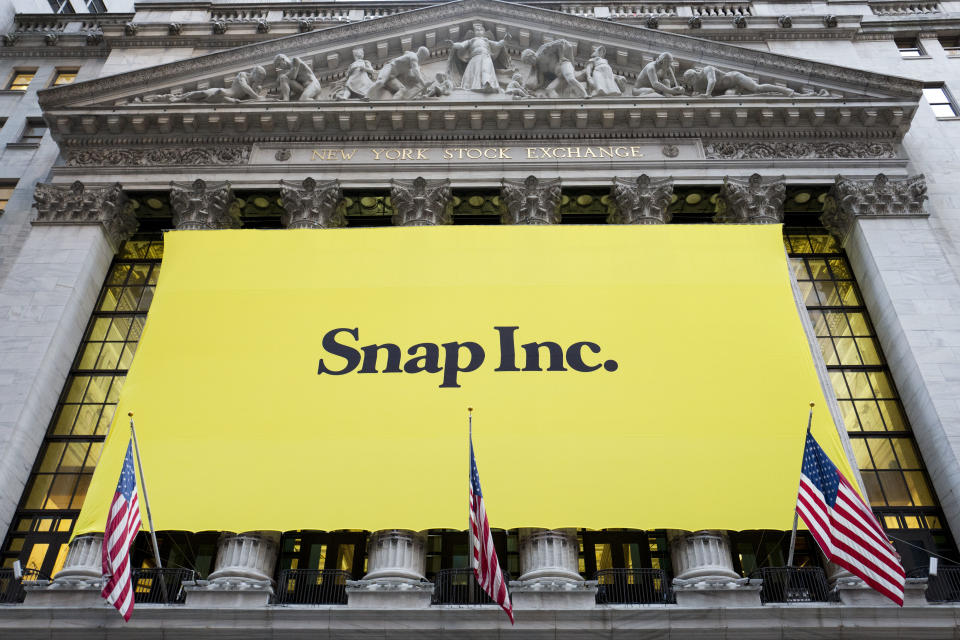S&P says Snap doesn't have what it takes to join the S&P 500

Last week Snap (SNAP), the parent company of the Snapchat app, one of the most popular social networks, held its initial public offering to immense fanfare and hype. Almost immediately, the stock shot up by $10 from the $17 price it had initially been priced as investors scrambled not to miss out on the next Facebook, which has almost quadrupled its value in the past five years.
While metaphorical lines were out the door, many institutional and retail investors did not partake in the frenzy. The reason? Snap isn’t yet part of the most popular index, the S&P 500, whose components are frequently purchased through an index fund or ETF. Since these index funds and ETFs are how huge numbers of people invest, admittance into the index is a big deal.
However, S&P Index Chair David Blitzer tells Yahoo Finance that as things stand right now, it’s not going to happen. “They don’t have profits at this point. Right now Snap is not eligible.” According to SEC filings, the company posted a net loss of $514 million last year.
In addition to having been profitable, there are a few more factors for a company. The main ones: It has to be large, $5.3 billion or bigger; at least 50% of its shares have to be public (not preferred stock held by founders, for example), and liquid, with its yearly shares traded at least equalling its market cap; and it has to be domiciled in the US and traded on a major exchange. And when a new one goes on, one often come off.
With a market capitalization of $26 billion and hot trading, Snap will likely have no issues meeting many of these criteria. But even if Snap becomes profitable, it will be some time before investors find out the answer. Getting on the index usually takes at the minimum six months, but a year is typical. “If it were going to be expedited it still has 5-and-three-quarter months to go,” Blitzer told Yahoo Finance. “But that doesn’t mean it’s going to be expedited.”
In the end there’s no hard and fast formula at Standard & Poor’s—it’s up to the committee to decide. And with Snap’s unique corporate governance, which has troubled many potential investors, the committee may decide to bar the company, something that groups like the Council of Institutional Investors have recently advocated. Unusually, Snap issued shares stripped of voting rights in its IPO, issuing Class A shares with no votes. Snap Class B shares, which have one vote each, will be offered to execs and pre-IPO investors, and Class C shares, with 10 votes each, are exclusively held by Snap’s CEO Evan Spiegel and CTO Bobby Murphy. This means the two co-founders have most of the power.
While there is no precedent for a company issuing no public voting shares, there are a few companies that do have non-voting stock that are still listed on the S&P 500. Back in 2014, Alphabet announced that it would issue vote-less class C shares (GOOG) in a stock split. This left the index in a pickle.
“We could have said we don’t want Class C,” said Blitzer. “In that case, we would have been telling an index fund: ‘Sell the Class Cs and turn around and buy Class A.’ And that would be a big trade.” Big trade is an understatement, as Google was one of the biggest companies in the index. “Had we done that, we [would have been] telling everyone to sell 1.25% of the index and buy it back. Index funds don’t like big trades.”
Instead, says Blitzer, S&P just changed the index after discussing the situation with ETF and fund managers. “That’s when we changed the rules to allow multiple share classes in the S&P.” (The S&P 500 index has both GOOG shares, which are non-voting, and GOOGL shares, which do have voting rights.)
According to Blitzer, this is unusual. There are only five different cases of multiple share classes in the index. However, dealing with a new non-voting class for one of its biggest and most important companies is not the same as a new upstart company run by a 26-year-old listing only non-voting shares.
For now, says Blitzer, it’s a moot point. “The methodology requires the company be making money under GAAP. And Snap is not making money.”
Ethan Wolff-Mann is a writer at Yahoo Finance focusing on consumer issues, tech, and personal finance. Follow him on Twitter @ewolffmann. Got a tip? Send it to tips@yahoo-inc.com.
Read more:
Multibillion-dollar Chinese play for American insurer likely doomed
We still don’t know how much Trumpcare will cost